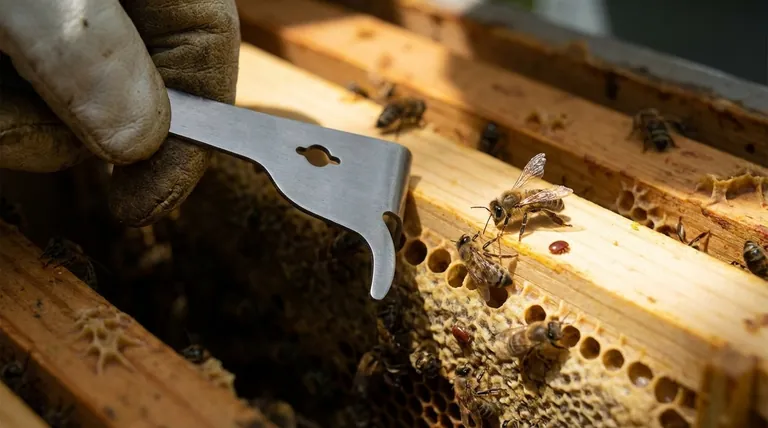At its core, a Varroa destructor mite infestation is the single greatest threat to honey bee colonies worldwide. The consequences range from weakening individual bees to causing the complete collapse of the hive, primarily by acting as a vector for transmitting deadly viruses.
The mite's true danger is not just that it parasitizes bees, but that it simultaneously injects them with highly virulent diseases. This one-two punch of weakening the bee and infecting it with viruses like Deformed Wing Virus (DWV) is what leads directly to catastrophic colony losses.

The Dual Threat: Parasitism and Disease
A Varroa mite infestation attacks a honey bee colony on two fronts. It weakens bees through direct feeding and, more critically, it efficiently spreads disease.
The Direct Damage of Parasitism
The mite feeds on the bee's fat body, a vital organ responsible for immune function, detoxification, and energy storage. This direct parasitism leaves the bee malnourished, weakens its immune system, and shortens its lifespan.
The Amplification of Viruses
Varroa mites are the primary vector for numerous bee viruses. As a mite feeds on one bee and then moves to another, it acts like a dirty needle, spreading pathogens throughout the hive.
This process also selects for more virulent strains of viruses. A virus that is too lethal to spread effectively between bees on its own can thrive when the mite provides a direct transmission route.
The Crippling Effect of Deformed Wing Virus (DWV)
The most notorious of these pathogens is Deformed Wing Virus (DWV). In a colony with low mite levels, DWV may be present without causing symptoms.
When transmitted by Varroa, however, DWV manifests in its most destructive form. Bees emerge with shrunken, useless wings and other deformities, rendering them completely unable to fly, forage, or contribute to the colony. They die within hours or days, representing a total loss of the hive's investment.
From Individual Bees to Colony Collapse
The damage to individual bees quickly escalates, compromising the entire colony's structure and leading to its eventual death, most often during the winter.
Weakening the Summer Workforce
Infestations during the spring and summer reduce the colony's productivity. Bees parasitized as larvae have shorter lifespans and are less effective foragers, leading to smaller honey crops and a slower population buildup.
The Link to High Winter Losses
The most critical impact occurs in the late summer and fall. High mite populations at this time target the generation of "winter bees," which are biologically adapted to live for several months and sustain the colony until spring.
When these crucial bees are parasitized, their fat bodies are diminished and their lifespans are drastically reduced. Even if the colony looks strong in October, a high mite load means the bees are not healthy enough to survive the cold.
This is why higher levels of Varroa infestation correlate directly with increased winter colony losses. A natural mite fall of just 3 mites per day in December is a recognized indicator of elevated risk.
Understanding the Cost of Inaction
Failing to manage Varroa mites is not a strategy; it is a direct path to colony failure. The consequences of neglecting this threat are predictable and severe.
The Need for Accurate Monitoring
You cannot manage what you do not measure. Simply looking at a colony is not enough to gauge the level of Varroa infestation, as most mites are hidden under brood cappings.
Waiting until you see visible signs of damage, such as bees with deformed wings, means the infestation is already at a critical, often irreversible, level.
The Role of Reliable Testing
The alcohol wash method is considered the most accurate and reliable way for beekeepers to determine their mite load. This method provides a clear "mites per 100 bees" number, allowing for informed and timely treatment decisions.
While it requires sacrificing a sample of bees, this small loss is insignificant compared to the catastrophic loss of the entire colony from an unmanaged Varroa infestation.
Making the Right Choice for Your Colony's Survival
Understanding the consequences of Varroa is the first step. Taking action based on accurate data is how you ensure your bees survive.
- If your primary focus is preventing colony death: You must monitor Varroa levels and treat the hive when they cross established economic thresholds, especially in the late summer.
- If your primary focus is maintaining a productive hive: Keeping mite loads low throughout the year prevents the constant drain on bee health that reduces honey production and population growth.
- If your primary focus is making informed decisions: Utilize a reliable testing method like an alcohol wash to get accurate data, removing the guesswork from your hive management.
Ultimately, proactive Varroa management is the defining responsibility of modern beekeeping.
Summary Table:
| Consequence | Impact on Colony |
|---|---|
| Direct Parasitism | Weakens bees, shortens lifespan, reduces immune function. |
| Virus Transmission | Amplifies deadly viruses like Deformed Wing Virus (DWV). |
| Reduced Productivity | Leads to smaller honey crops and slower population growth. |
| High Winter Losses | Compromises winter bee health, causing colony collapse. |
Protect your apiary's health and productivity. HONESTBEE supplies commercial apiaries and distributors with the essential tools and equipment for effective Varroa mite management. From testing kits to treatment solutions, we provide the reliable supplies you need to safeguard your investment. Contact our wholesale experts today to discuss your needs.
Visual Guide

Related Products
- Professional Multi-Function Stainless Steel Hive Tool
- Commercial Grade Vertical Electric Bee Sweeper for Bee Removal
- Long Langstroth Style Horizontal Top Bar Hive for Wholesale
- Professional Insulated Winter Hive Wrap for Beekeeping
- Professional Adjustable Timer Electric Wire Embedder
People Also Ask
- How can a modified hive tool be used to clean the smoker? A Guide to Reliable Beekeeping
- Why is frequent monitoring of hives important? Master Proactive Beekeeping for Colony Health
- How is a hive tool used for scraping and cleaning? Master Hive Maintenance for a Healthy Colony
- What are the normal functions of a hive tool? The Essential Multi-Tool for Every Beekeeper
- How should beekeepers handle bees when using a hive tool? Master Calm, Deliberate Techniques



















